#Dino Mech Gaiking
Text
(#MechaMarch2024) Dino Mech Gaiking - Broken People From War
Go Nagai and Legal Battles
Go Nagai is an incredible creator with an amazing sense of creativity. He is also an infinitesimally horny person that has created some very raunchy works. At the same time, Go Nagai was also a very creative mind. Along with that, he has created some really edgy works that make so many turns no one expects to occur for better or for worse. Those three things usually…
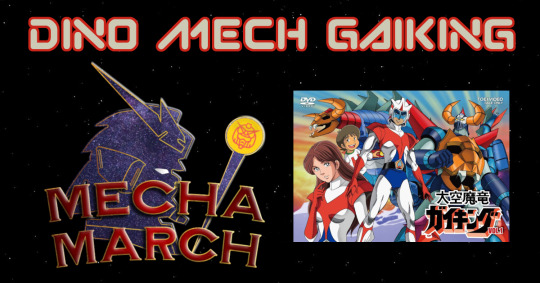
View On WordPress
0 notes
Text
Discotek Media Announces Anime Releases for January 2023
Discotek Media Announces Anime Releases for January 2023
Discotek Media has announced that it will release the City Hunter Classic Movies and TV Specials Collection, The King of Braves GaoGaiGar television series and the Japanese language version of Shaman King on Blu-ray, as well as Tetsujin 28 FX, Virtua Fighter the Animation and Dino Mech Gaiking on Standard Definition Blu-ray on January 31, 2023.
City Hunter Classic Movies and TV Specials…

View On WordPress
#anime#City Hunter#Dino Mech Gaiking#Discotek Media#Shaman King#Tetsujin 28#The King of Braves: GaoGaiGar#Virtua Fighter
1 note
·
View note
Text
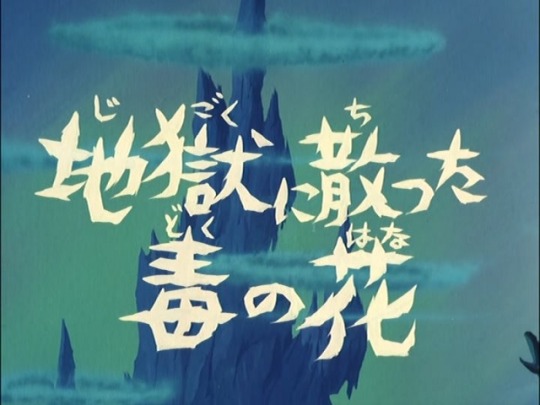
Let's conclude our Cutie Honey 50th anniversary trivia with the final episode: “A Poison Flower Falls to Hell.”
Screenwriter: Masaki Tsuji
Art Director: Urata Mataharu
Animation Director: Satoshi Jingu
Director: Osamu Kasai
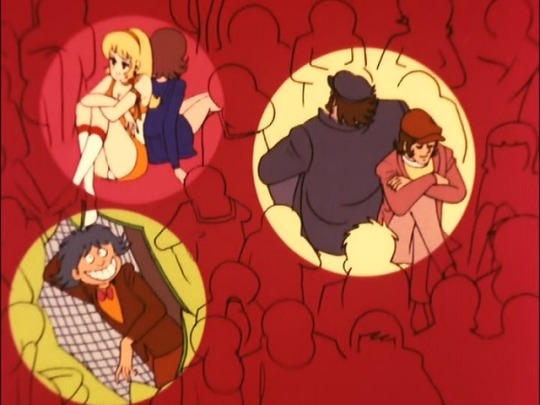
With the exception of Junpei’s girlfriend Mami and the nameless Panther Claw subordinates, all of the (living) characters in the series appear for the final episode.
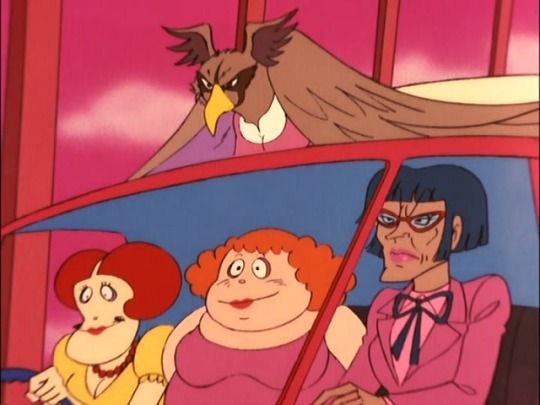
The suspenseful drumming that plays before Eagle Panther attacks the truck was lifted from Go Misawa’s soundtrack for Devilman.
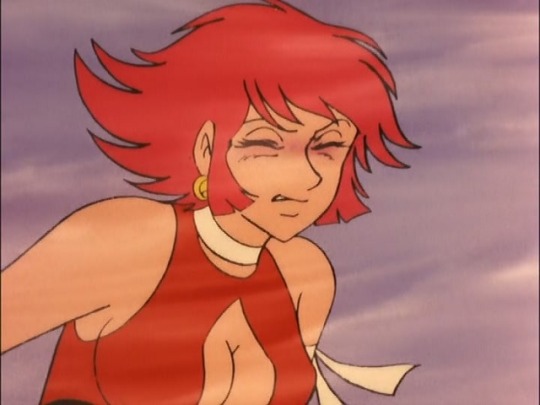
Honey has always lovingly addressed her father as “papa”, but in this episode she refers to him as the more formal otousama or “father.” This was probably done to demonstrate to the audience how much she has grown from her battle with Panther Claw.
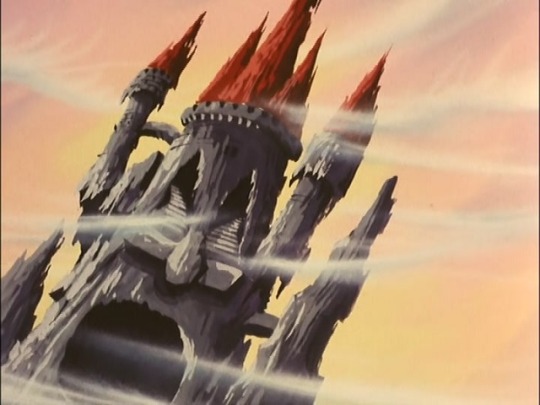
In the original manga, Sister Jill’s headquarters was called maboroshi jyou or “Castle of Illusion.” The name was probably changed to avoid confusion with Cutter Claw’s “Castle of Illusion” from episode 10.
Jill’s headquarters in the manga looks like a traditional European style castle, while the anime version evokes more of a haunted house.
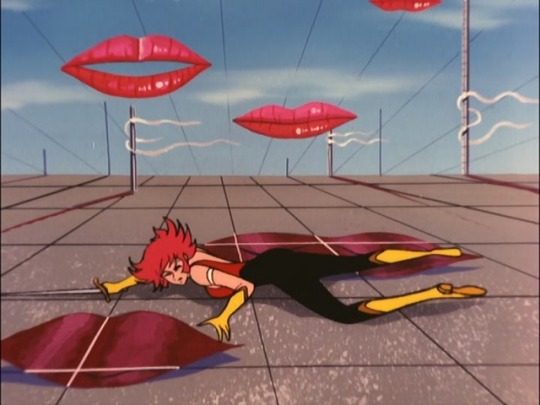
The dreamlike landscape Honey falls into is modeled after the surrealist works of Salvador Dali, specifically one of his most famous works, The Persistence of Memory, which depicts melting pocket watches. The floating lips could possibly be based on Man Ray’s Observatory Time: The Lovers, a painting featuring a giant pair of lush red lips in the sky.

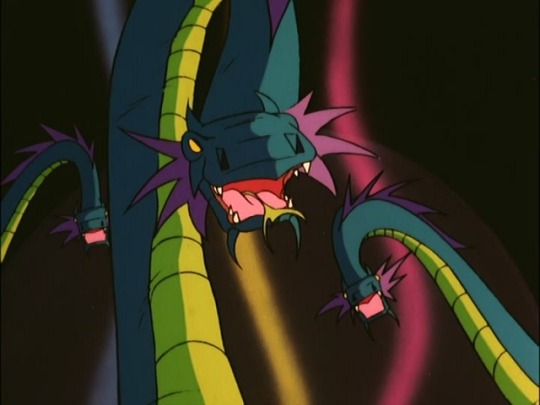
The second half of the episode features a few references to one of Toei Animation’s earlier films, The Little Prince and the Eight-Headed Dragon.
Released in 1963, the film tells the story of Susanoo, the youngest son of the gods who created the Earth, and his journey in finding his mother. The stylized film featured the talents of animation veterans such as Yasuo Otsuka, Yoichi Kotabe, Isao Takahata, and Kimio Yabuki.
References to The Little Prince and the Eight-Headed Dragon:
The human shaped fire that attacks Honey is animated almost exactly like the Fire God that Susanoo faces.
The phantom serpents are a dead-ringer for the eight-headed dragon. The only difference is the coloring. In the film their colors are similar to Maleficent's dragon form from Walt Disney’s Sleeping Beauty. It’s worth mentioning in the original storyboard the illusions were meant to look like generic snakes.
After the Panther Chateau crumbles, the gloomy skies clear up and Honey finds herself in a flowerbed under a blue sky. This is similar to the end of the film, in which the defeated dragon turns into a field of flowers and the dark skies become bright and sunny.
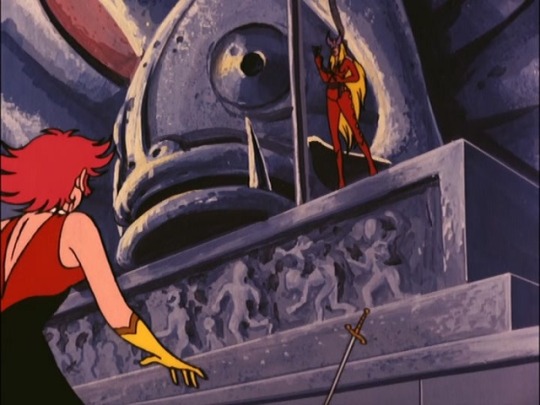
The bone-chilling organ music that plays during Honey and Jill’s confrontation is Fugue in D Major, BWV 580 by Johann Sebastian Bach. The rendition featured in this episode was performed by French organist Marie-Claire Alain.
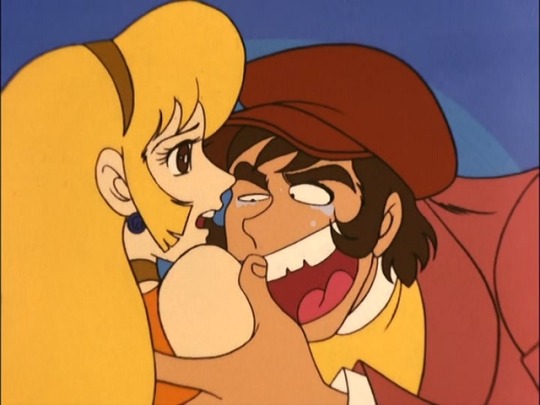
While the animation director for the finale is Satoshi Jingu of Anime Room, the key animation for the second half of the episode was handled primarily by Yoshinori Kanada. While he was relatively unknown at the time, he would go on to be a very influential figure in the animation world, working on titles such as Dino Mech Gaiking, Birth, Princess Mononoke and others. Kanada’s style is particularly noticeable during the “Honey Special” sequence and Honey's reunion with the Hayami family.

Although this is the only instance where Kanada is listed in the credits, Kazuhiro Ochi has confirmed he did in fact work on the other episodes that were animated by Anime Room (6, 13, 24, and 25).
Supposedly, the final episode was originally going to be handled by Shingo Araki and Hiroshi Shitara, but both men were too busy working on Majokko Megu-chan.

Despite getting pretty good ratings, Cutie Honey was canceled due to concerns over salacious content. According to Go Nagai’s autobiographical manga, Gekiman! Cutie Honey Hen, nearly everyone involved was blindsided by the cancellation. Toshio Katsuta in particular was quite surprised, since Honey made better ratings than its predecessor, Microid S. Katsuta was actually quite confident Honey would last three or four seasons.
Because of the series' abrupt cancellation, Katsuta and Nagai both agreed to have Honey defeat Jill at the end of the series, while leaving Panther Zora’s fate being left to the interpretation of the fans.
In an interview printed in the 1981 Cutey Honey Roman Album, Go Nagai talks a little bit about what Honey and Zora were up to after the finale. He says Zora began harvesting animals from the Amazon and transforming them into androids, probably in preparation for a battle against Honey. He also says Honey is destined to only fight Panther Claw, so she'd probably ignore any unrelated criminal activity. I guess we can assume Honey got a little downtime after her victory against Sister Jill?
And that's all our trivia for Cutie Honey! I hope you enjoyed all the interesting tidbits I've collected over the years. Maybe someday I'll do this for the other series...

Special Thanks:
@brickme
Ayumi Shinozaki
Josh M.
Charlie from Skaro Hunting Society
Phix Cabral
Jonathan Castleman
14 notes
·
View notes
Text
An Abbreviated History of Mecha Addendum 1: Assemble the Forces!

Welcome to the first addendum to An Abbreviated History of Mecha! Today, we'll be looking at some of the media that came out in the 70's and before. A lot of the shows covered here are ones that were fairly big in their own right, especially when compared to the juggernauts of the era like Ultraman, Mazinger Z, and Getter Robo. What should also not surprise anyone with a lot of the shows listed here is that a bunch of the shows listed here have one Go Nagai and Dynamic Planning attached to them in some manner.
Because of course he is.
And I should note: unlike in An Abbreviated History of Mecha proper, the addendums will not be listing these entries in chronological order. This primarily because a) I need to get back into the groove of writing one-off posts (especially after The Devil That is Capitalism), and b) there are a lot of things that slipped out of the cracks, and I treasure my sanity.
Anyways, let's get down to brass tacks.
Daiku Maryu Gaiking (1976) and Gaiking: The Legend of Daiku Maryu (2005)

Daiku Maryu Gaiking (or Dino Mech Gaiking) is a 1976 giant robot series known for having plots take place in real world locations outside of Japan and also for featuring the first ever use of a carrier ship for the titular giant robot Gaiking. Gaiking is also somewhat infamous due to Toei trying their absolute hardest not to pay Go Nagai since he and Dynamic Planning created the series.
Toei would revisit Gaiking in 2005 with the release of Gaiking: the Legend of Daiku Maryu, which would feature a largely unchanged Gaiking and Daiku Maryu but feature a completely different main character.
Kotetsu Jeeg/Steel Jeeg (1975) and Kotetsushin Jeeg (2007)

Created by Go Nagai immediately following the success of Mazinger Z and Great Mazinger, Kotetsu Jeeg alongside its sibling series UFO Robot Grendizer would help to cement Nagai's legacy as one of the big mecha creators in the canon. Kotetsu Jeeg would receive a sequel in 2007, Kotetsushin Jeeg. The sequel was directed by Jun Kawagoe of Getter Robo Armageddon and Mazinkaiser SKL fame and features JAM Project performing the OP Stormbringer.
In other words, Kotetsu Jeeg beat Mazinger Z to the punch with the distant sequel. Or I guess you could say it beat Mazinger Z to the rocket punch?
Eh? Get it? No? Okay...
Planetary Robot Danguard Ace (1977)

Danguard Ace is one of the many mecha shows that came out in the wake of giants like Mazinger Z and Getter Robo. This series is noteworthy for being Leiji Matsumoto's first and only foray into the giant robot genre of mecha.
And hey, guess who's currently the owner of the Danguard Ace property?
It's Go Nagai and Dynamic Planning.
Abassador Magma (1965)

Ambassador Magma is a manga series created by Osamu Tezuka. It would also receive a tokusatsu series shortly after, with one of its big accomplishments being that it would be the first tokusatsu series aired in color. Specifically, it would beat honorary mecha show Ultraman to the punch by about six days.
Invincible Robot Trider G7 (1980)

Something to always keep in mind with the history of mecha is that Mobile Suit Gundam was not initially a hit. Invincible Robot Trider G7 serves as a good reminder of this, as it was an anime series produced by Sotsu (as in the very same Sotsu that also produced the original Gundam alongside Sunrise). Airing at around the same time as Space Runaway Ideon, Trider G7 would mark the beginning of giant robots being used in the deep recesses of space alongside Ideon.
Future Robot Daltanious (1979)

I couldn't find a good gif for Daltanious without watching the series myself, so we'll have to make do with this promotional image instead.
Future Robot Daltanious is a 1979 anime series that had Tadao Nagahama as its original director for its first couple of episodes before he left to direct the seminal Shoujo series The Rose of Versailles (a series that really should be treated as an honorary mecha series due to its influence on anime and manga as a whole). Even though he only worked on the series for about thirteen episodes and passed away before he could come back to work on it, Daltanious is still treated as one of his shows alongside Combattler V, Voltes V, and Daimos.
Daltanious is also an important series for those familiar with the Brave franchise, as Daltanious is the design inspiration for both Exkaiser and GaoGaiGar.
Super Robot Red Baron (1973) and Super Robot Mach Baron (1974)

Super Robot Red Baron would come onto the scene in 1973 as the giant robot tokusatsu shows would wane in abundance due to their expensive natures. Red Baron, and later its sequel series Mach Baron, would serve as a sort of swan song as it would also have to compete with one Mazinger Z for the hearts of children all across Japan. Giant robot tokusatsu wouldn't go away altogether though, and we'd see this with the next and arguably one of the weirdest entries both here and in the canon of comic book history.
Toei Spider-Man (1978)

In cooperation with Marvel Comics (yes really), Toei would put out their own version of Spider-Man towards the end of the 70's. Note that this is specifically in a post-Kamen Rider/Super Sentai world, so Spider-Man in this series is less "quippy teenager living up to his uncles words about great power and great responsibility" and more "the warrior of hell fighting aliens" (although, I'm pretty sure either Peter Parker or Miles Morales have fought the forces of hell at this point).
Also Spider-Man in the Toei series pilots a giant robot named Leopardon to fight giant alien monsters. This may be funny, but Leopardon is important because it is what inspires Super Sentai to include giant robots in all of their future shows.
Also, to the folks at Marvel. Sony and the production crew behind the Spiderverse films: when are we going to get Toei Spider-Man in the Spiderverse films?
Jumbo Machinder/Shogun Warriors

Image source: Shogun Warriors unofficial website
Finally, to round out today's post, how could I not mention the Jumbo Machinder line of toys. All jumbo machinder was was a line of toys based off of popular giant robot shows like Mazinger Z, Gettero Robo G, Brave Raideen, Gaiking, and many more (also Godzilla and Rodan had their own machinder toys). The toys all came with spring-loaded projectiles and were immensely popular with kids back in the day.
Mattel would eventually get the distribution rights to these toys, bringing them over to the US as the Shogun Warriors. Mattel would also ask Marvel Comics to write a comic series for the Shogun Warriors that would explain why all of these largely unrelated giant robots were working together.
Thank you for reading this addendum to An Abbreviated History of Mecha. Normally, I'd do a conclusion section, but I feel like I'd have to follow up with another Addendum post.
#anime and manga#mecha#an abbreviated history of mecha#anime history#daiku maryu gaiking#gaiking#kotetsu jeeg#steel jeeg#danguard ace#ambassador magma#trider g7#future soldier daltanious#toei spider man#spiderman#shogun warriors#super robot red baron#jumbo machinder
0 notes
Photo





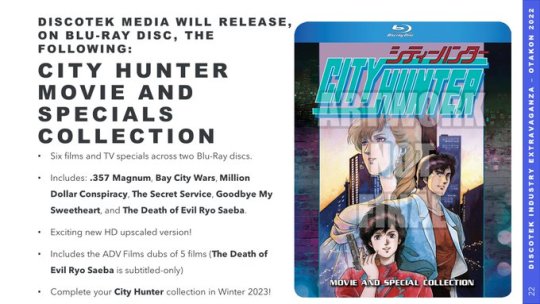
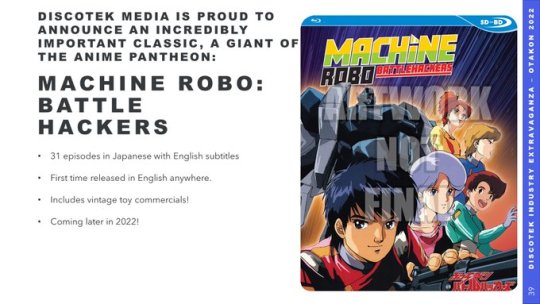
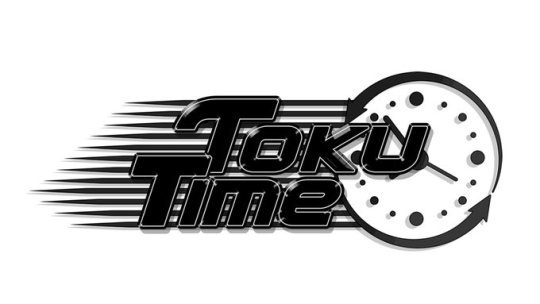
Announcements from Discotek’s Otakon 2022 panel! Lots of exciting news, including finally getting confirmation that Discotek will be putting out the original Urusei Yatsura TV series in 4 bluray sets, starting next year! Discotek also announced they have made a new tokusastu imprint label called Toku Time, which will be what their toku shows will be branded with in the future. Check out all the images above for most of the new classic release info they announced at the panel!
#news#Discotek Media#Urusei Yatsura#Project A-ko#Lupin III The First#Sherlock Hound#Dino mech Gaiking#City Hunter#Machine Robo#80s anime#70s anime#anime on bluray#Otakon 2022#tokusastu
103 notes
·
View notes
Text

Yamagatake From Dino Mech Gaiking. I don't really know this guy or the anime has from, but I will say that he's a huge beefy sumo and I love those.
4 notes
·
View notes
Text
Anime List from “History of Mecha: The 60s and 70s”

As promised, here are two lists for you related to “History of Mecha Pt. 1: The 60s and 70s”. The first list covers all of the anime we mentioned during the course of the panel and in the order in which they were mentioned. The second, longer list below is the one which includes everything in the applicable decades that fit into our determinate factors for mecha anime that we ascribe to the purposes of the panel series. Do enjoy!
Shows in the panel:
1. Tetsujin 28 [1963]
2. Flying Ghost Ship [1969]
3. Astroganger [1972]
4. Mazinger Z [1972]
5. Zero Tester [1973]
6. Getter Robo [1974]
7. Great Mazinger [1974]
8. Mazinger Z vs. Devilman [1973]
9. Mazinger Z vs. The General of Darkness [1974]
10. Brave Raideen [1975]
11. Super Electromagnetic Robo Combattler V [1976]
12. Super Electromagnetic Machine Voltes V [1977]
13. Tosho Daimos [1978]
14. Invincible Superman Zambot 3 [1977]
15. Mobile Suit Gundam [1979]
All mecha shows:
1. Tetsujin 28 [1963]
2. Tetsujin 28: The Birth [1964]
3. Flying Ghost Ship [1969]
4. Astroganger [1972]
5. Mazinger Z [1972]
6. Mazinger Z vs. Devilman [1973]
7. Zero Tester [1973]
8. Getter Robo [1974]
9. Mazinger Z vs. The General of Darkness [1974]
10. Great Mazinger [1974]
11. Great Mazinger vs. Getter Robo [1975]
12. Brave Raideen [1975]
13. Getter Robo G [1975]
14. Tekkaman: The Space Knight [1975]
15. The Great Battle of the Flying Saucers [1975]
16. Great Mazinger vs. Getter Robo G: The Great Space Encounter [1975]
17. Kotetsu Zieg [1975]
18. UFO Robo Grendizer [1975]
19. UFO Robo Grendizer vs. Great Mazinger [1976]
20. Dino Mech Gaiking [1976]
21. Gowapper 5 Godam [1976]
22. UFO Senshi Daiapolon [1976]
23. Super Electromagnetic Robo Combattler V [1976]
24. Groizer X [1976]
25. Blocker Gundan IV Machine Blaster [1976]
26. Grandizer, Getter Robot G, Great Mazinger Decisive Battle! The Great Sea Monster [1976]
27. Magnos the Robot [1976]
28. UFO Senshi Daiapolon II [1976]
29. Gasshin Sentai Mechander Robo [1977]
30. Planet Robot Danguard Ace [1977]
31. Ginguiser [1977]
32. Super Electromagnetic Machine Voltes V [1977]
33. Balatack [1977]
34. Danguard Ace vs. Insect Robot Troop [1977]
35. Invincible Superman Zambot 3 [1977]
36. Danguard Ace: The Great Space War [1978]
37. Tosho Daimos [1978]
38. Invincible Steel Man Daitarn 3 [1978]
39. Daikengo [1978]
40. Future Robo Daltanius [1979]
41. Mobile Suit Gundam [1979]
42. Toshi Gordian [1979]
#nos anime#anime#anime research#anime analysis#mecha#mecha anime#mecha history#history of mecha#real robot anime#super robot anime
11 notes
·
View notes
Text
Gaiking: The Legend of Daiku-Maryu - One Boy's Journey of Discovery
A Wonderful Reboot
It’s not often that I watch a show that takes on the ideas of an older anime series with modern animation and fills the show with details that weren’t there beforehand. Space Battleship Yamato 2199 is a great series that takes the original, already good Yamato series and makes it even better. This show is for Dino Mech Gaiking, something I reviewed for Mecha March this year…
0 notes
Text
(#MechaMarch2024) Psycho Armor Govarian
An Aftermath of Go Nagai vs Toei
After the rights fiasco of Go Nagai suing Toei for removing his name from Dino Mech Gaiking for the royalties, there was a long legal battle between the two. All of which meant that Toei still held the rights for a lot of Go Nagai’s properties for a while and Go Nagai moved over to Studio Knack for a while. You know, the studio that produced the horrible and meme…

View On WordPress
0 notes
Text
Discotek Media's Announcements at Otakon 2022
Discotek Media’s Announcements at Otakon 2022
Discotek Media announced during its panel at Otakon 2022 that it has licensed the following titles:
The 1981-1986 Urusei Yatsura anime
The City Hunter films and specials
Machine Robo: The Running Battlehackers
Senki Zesshō Symphogear XV
The Princess and the Pilot
The Tales of Symphonia OVAs
Discotek also revealed more details for its release of Project A-ko 3: Cinderella Rhapsody, Shaman King,…

View On WordPress
#anime#Cat&039;s Eye#City Hunter#Dino Mech Gaiking#Discotek Media#Machine Robo#Otakon#Project A-ko#Shaman King#Sherlock Hound#Symphogear#Tales of Symphonia#The Princess and the Pilot#Urusei Yatsura
2 notes
·
View notes
Text
Anime Screenwriter Shozo Uehara Passes Away
Anime Screenwriter Shozo Uehara Passes Away

Screenwriter Shozo Uehara passed away on January 2, 2020 due to liver cancer. He was 82 years old at the time of his passing.
Uehara was born in Okinawa in 1937. After graduating from Chuo University, he joined Tsuburaya Productions.
Uehara’s anime credits include writing scripts for Getter Robo, UFO Robo Grendizer, Dino Mech Gaiking, Space Pirate Captain Harlock, Captain Harlock: Mystery of the…
View On WordPress
0 notes